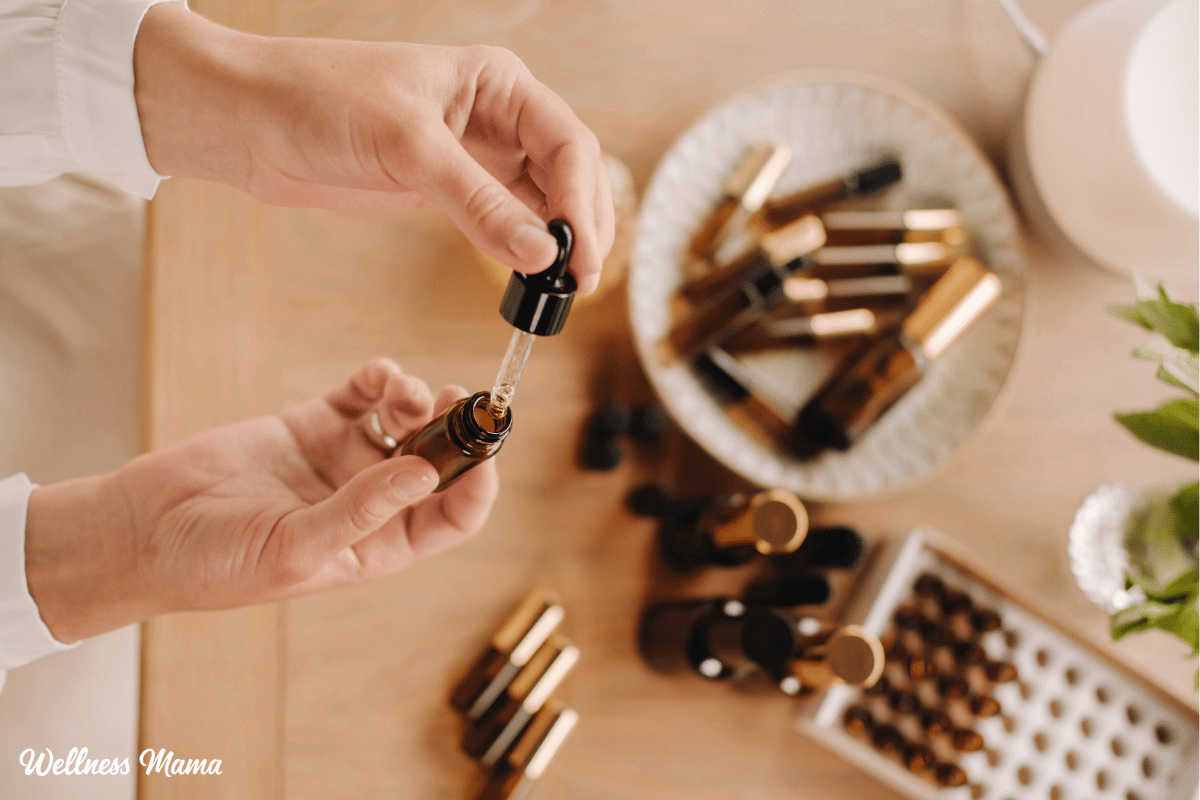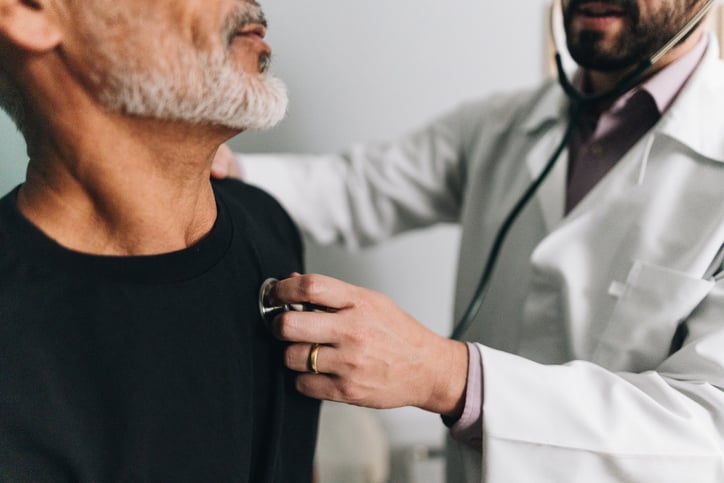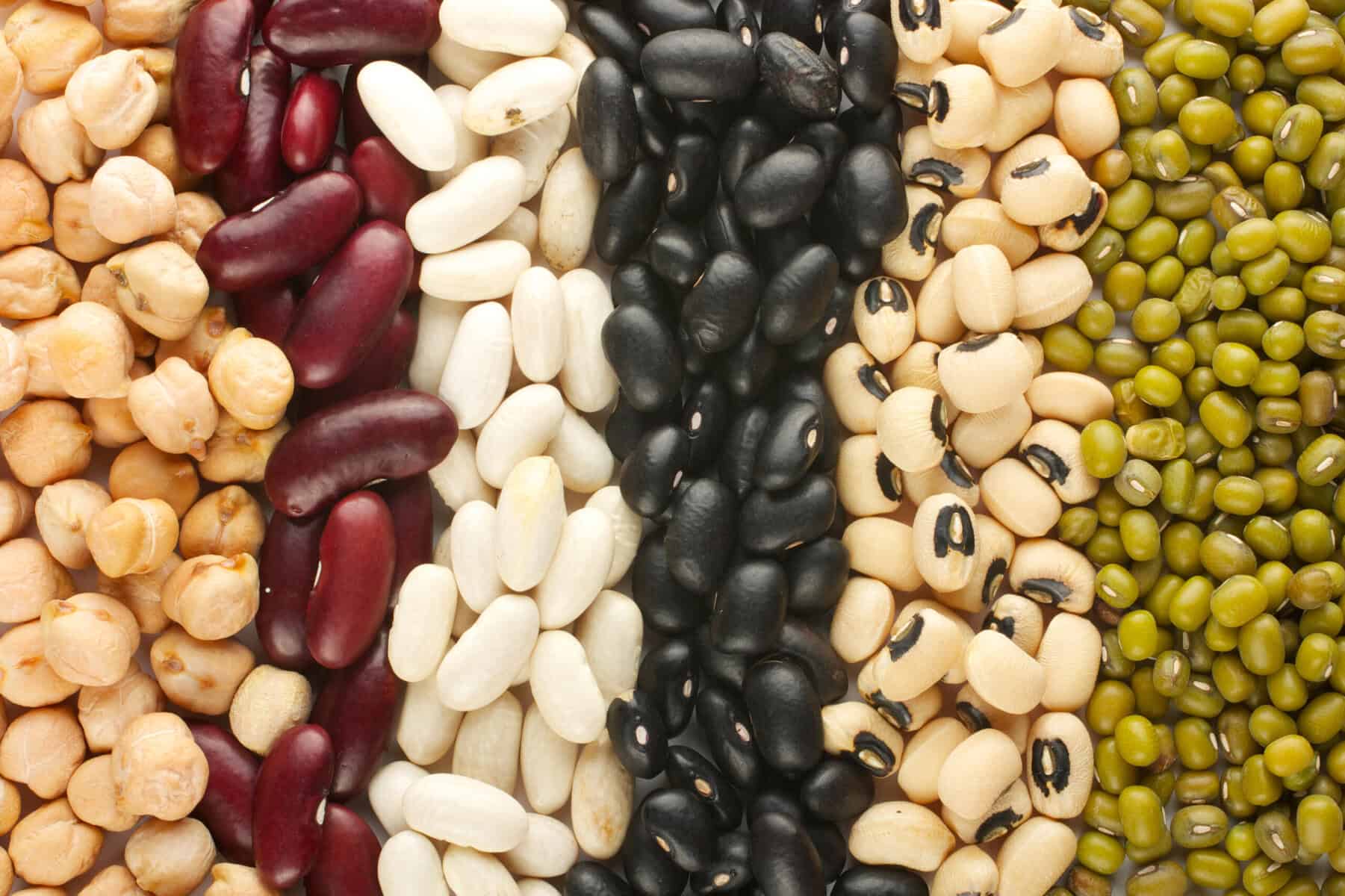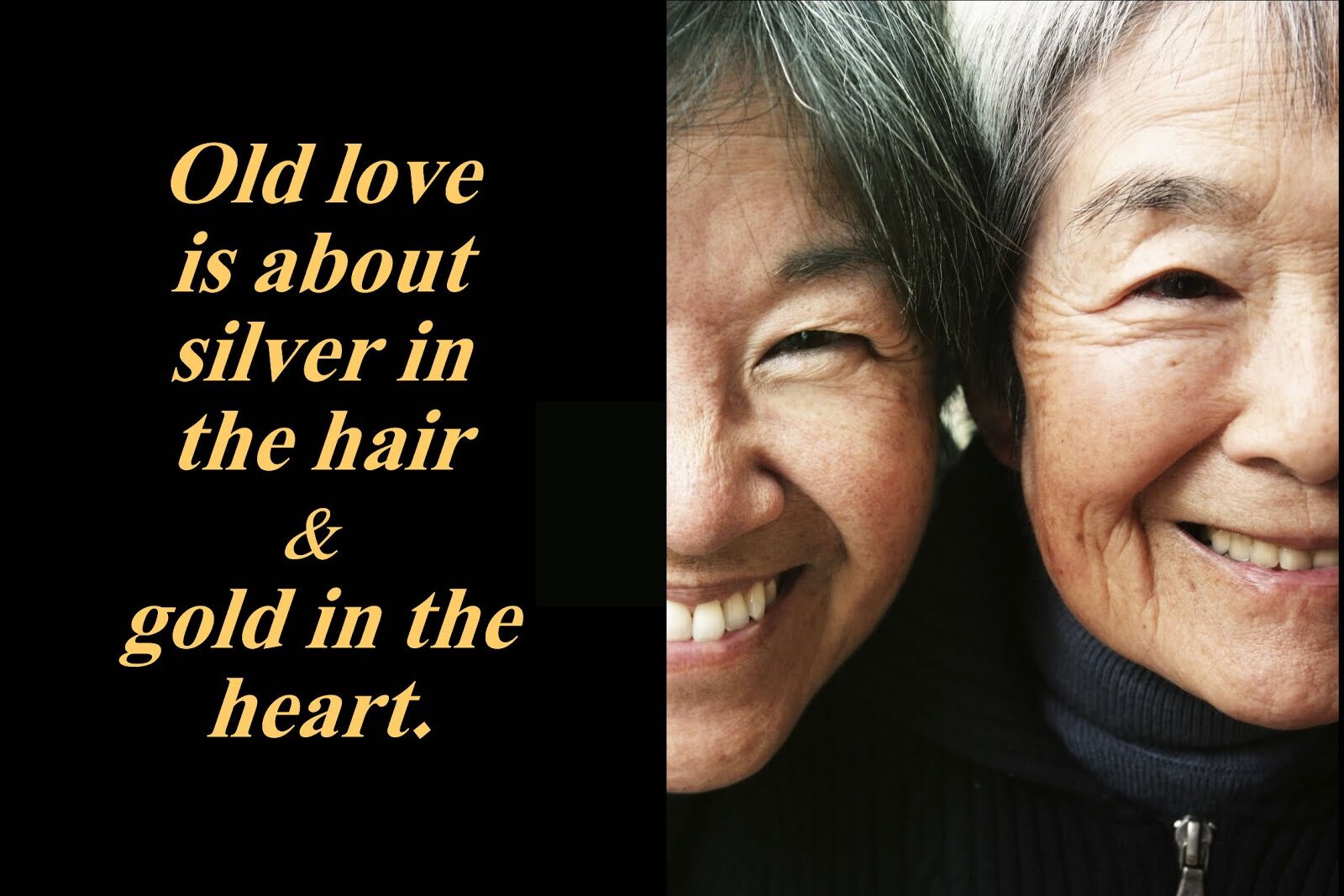
Feeling a little lost when it comes to essential oil safety? These increasingly popular plant oils are very powerful and useful, but they also pose very real risks. Over the years I’ve done some digging on how to use them safely and they’re something our family uses daily. However, I’m not a fan of blanket advice about how to use (or not use!) them.
Don’t get me wrong. I love oils and I use them daily. Most often, I use them diluted in natural beauty or cleaning recipes, but I also use them aromatically and therapeutically at times. Because they’re so strong though, I don’t want to over use them for myself or my family. Here’s why.
Essential Oils are Highly Concentrated
Did you know it can take hundreds or even thousands of pounds of plant material to make a tiny bottle of essential oil? Some essential oils, like orange, naturally yield more oil. While other plants like Melissa take a whole lot more. This translates to a very concentrated and potent natural remedy.
Some sources say one drop of peppermint essential oil is the same as 26 cups of mint tea, but it’s not quite as simple as that. When we use herbs we’re using a much wider range of chemical constituents that naturally balance each other. Essential oils on the other hand are just the volatile oils in isolation. That means they have different properties and slightly different uses than the herb as a whole.
Essential oils can be a great tool when they’re used properly… in safe amounts.
Essential Oils on the Skin
I use diluted essential oils in many of my beauty recipes like lotion bars and herbal face oil. The key word though is “diluted,” using a carrier oil, like olive oil or avocado oil. There are times when it can be helpful to use undiluted essential oils. However, you really need to know what you’re doing, or work with an aromatherapist who does.
So what can happen if you don’t dilute your essential oils? You might notice skin redness, irritation, itching, burning, or an allergic reaction. Even if you don’t notice any symptoms right away your skin can become sensitized over time. This means that suddenly an oil that’s given you no issues before causes a severe reaction. Often the body can never use that essential oil again, even if you try it again diluted or diffused.
Certain essential oils, like cinnamon, clove, and lemongrass are more likely to cause a reaction. However, all essential oils have the potential to cause reactions when not used properly. I’ll test a new essential oil diluted on my arm before using it on a larger area of my body.
How to Dilute Essential Oils
This is a tricky one to answer and has a lot of nuance to it. How much you should dilute an essential oil depends on the following:
- The person’s age (babies and the elderly have thinner skin so higher absorption rates)
- Their state of health and if they have any medical conditions
- Where you apply the essential oil on the body and how large/small of an area
- Which oil you use and what you’re using it for
Most oils have a maximum safe dilution rate and some can be quite low. Safe dilution can range from .25% to about 20% depending on various factors. As a general rule though, safe essential oils are okay to use in skincare products at around a 2% dilution. This translates to about 6 drops of essential oil per 1 Tablespoon of carrier oil.
My Massage Horror Story
I learned first hand the hard way what can happen when you use too much undiluted essential oil. Years ago I tried a new massage therapist in town who offered an “aromatherapy” massage. I assumed this meant there would be essential oils in a diffuser during the massage. To my surprise, as the massage began I felt drops on my back.
I realized a few seconds later that she was pouring essential oils on my back… a lot of them. I asked her what oils she was using and she assured me that they were safe, but I got a headache soon after. She probably poured 80+ drops of undiluted essential oils on my back, which gave me shivers, a headache, and a 12-inch red spot on my back that lasted for days.
Not only did she not ask if I was pregnant or had health conditions first, but I found out she wasn’t even a licensed masseuse! Needless to say it was not a pleasant experience. Bottom Line: Exercise caution and do your research before using essential oils on the skin.
Phototoxic Essential Oils
Certain essential oils have constituents, mainly furocumarins, that can make skin more sensitive to UV light. The result are blisters and burns even after mild sun exposure. Phototoxic essential oils are mainly citrus oils, but not every citrus oil has furocumarins. And steam distilled citrus oils don’t have this issue.
Each of these oils also has a safe dilution rate where it’s much less likely to cause photosensitivity, but for many the margin of error is quite tight. To keep things simple, the following essential oils are best avoided before sun exposure if used in a leave on product (like lotion).
- Bergamot (Cold Pressed)
- Bitter Orange (Cold Pressed)
- Grapefruit (Cold Pressed)
- Lemon (Cold Pressed)
- Lime (Cold Pressed)
- Mandarin Leaf
Sweet or wild orange is the exception and is not phototoxic.
Using Essential Oils Internally
This is where things get really sticky. On one hand there are groups telling people to drink essential oils in their water. While others say it is never okay under any circumstance to ingest essential oils. Like most things, the truth lies somewhere in the middle.
If you’ve ever used lemon extract or sucked on a peppermint, then you’ve ingested essential oils. They’re commonly used in the food industry as natural flavoring in tiny amounts. That doesn’t mean they’re safe to ingest under every circumstance though, especially in large amounts. Remember, essential oils are highly concentrated substances!
The Gut Factor
Many sources tout essential oil’s antimicrobial properties. You know what else is teeming with many types of microbes? Your gut.
Research is constantly emerging about our extremely diverse gut microbiomes, but we still don’t fully understand them. We do know that gut health drastically affects other aspects of health. Gut imbalances can cause problems in the skin, brain, and other parts of the body. While more research has gone into essential oil’s effect on gut bacteria, there’s still a lot of unknowns.
Researchers have suggested certain essential oils are even as potent as prescription antibiotics. Other studies show how essential oils benefit certain gut microbes and lead to positive health changes. The bottom line is there’s still a lot we don’t know and it’s wise to exercise caution if you choose to use essential oils internally.
Many essential oils are considered “GRAS” or Generally Recognized as Safe for food and cosmetic use. However, many essential oils have not been studied in internal amounts in real life situations. It’s worth doing your research before trying this route.
Essential Oils During Pregnancy or Nursing
Essential oils can affect hormones, gut bacteria, and other aspects of health. Caution should be used when using them while pregnant or nursing. Like most things, essential oils may cross the placenta and get to baby.
Am I saying never use them? No… but do your research first and/or work with a qualified aromatherapist in these circumstances. Much of the research that’s been done on essential oil’s effect on unborn babies has some obvious limitations. Some researchers use isolated constituents, not essential oils in their whole form. Or they’re given in massive doses in animal studies that are much higher than anyone would consume in real life.
One study found that oregano essential oil is toxic to the embryos of pregnant rats. However, the rats were fed 150 mg of essential oil for every kilogram of their body weight. This is the equivalent of giving the average woman well over 2 teaspoons of essential oil.
What I Did During Pregnancy and Nursing
I personally don’t take any essential oil internally during pregnancy (or even while nursing). I stick to aromatherapy and very diluted use of pregnancy safe essential oils in skin care recipes and baths. Plus, I always re-test an oil in a diluted skin test before using it during pregnancy.
It’s best to use caution with any plant medicine during pregnancy, especially during the first trimester. Some essential oils have hormonal effects that can cause miscarriage or other side effects.
Pregnancy Safe Essential Oils
Don’t throw the baby out with the bathwater though! Essential oils can be very helpful during pregnancy, when used appropriately. Here are a few ways to use essential oils to help with pregnancy complaints. As always, be sure to check with your midwife or someone trained in essential oil use during pregnancy before using.
- Inhale peppermint or lemon to help with nausea
- Diffuse lavender to help with sleep
- Massage with frankincense to help ground, relax, and soothe achy muscles
The International Federation of Aromatherapists recommends using a maximum dilution rate of .5% to 1% during pregnancy. This would be 3 to 6 drops of essential oil for every 2 Tablespoons of carrier oil. You can find an extensive list of essential oils to avoid during pregnancy here.
Peppermint essential oil can decrease milk supply so I avoided it topically while nursing.
Essential Oil Safety For Babies and Children
This is one of the things that concerns me the most with a lot of the essential oil recommendations I see online. I don’t ever give essential oils internally to children or use them undiluted on their skin. Children, especially babies, need less essential oils than adults do when using them topically. Even essential oils that may seem “gentle,” like lemongrass, can be very irritating to skin if too much is used.
Aromatherapy For Kids
Diffusing essential oils is one of the safest ways to get their benefits. My friend Heather has a really great and very thorough list of which essential oils are safe for each age group.
In general though, oils like lavender, chamomile, orange, lemon, and frankincense are helpful for even young children. These can be diffused or diluted and applied topically as needed.
Risks For Children
In extreme cases, essential oil misuse has caused seizures in some children. To clarify, the case studies on these are rare and the children were predisposed to seizures. However, it points to how powerful essential oils can be.
Some oils, like peppermint, rosemary, eucalyptus, and wintergreen have specific precautions around little ones. These herbs contain menthol and 1,8-cineole that can slow breathing (or even stop it) in very young children when misused. Aromatherapy expert Robert Tisserand recommends avoiding peppermint for children under age 3 and diffusing or diluting eucalyptus oil at .5% for children ages 3 to 6.
The University of Minnesota also cautions about the use of peppermint and similar oils in young children with G6PD deficiency (a common genetic enzyme deficiency). These children can get severe jaundice from using these oils.
I prefer using safe essential oils in a diffuser or in very diluted amounts in beauty and cleaning products. Important note to add: pets can be just as vulnerable.
Essential Oils in Plastics
It’s not often mentioned, but essential oils really should be stored in glass containers. Essential oils can dissolve some plastics, even when diluted, or degrade the plastic over time. While certain plastics can be okay for essential oil storage, they’re not the safest option. I store my homemade cleaners and beauty products in glass whenever I can for this reason.
This caution also extends to other surfaces in the house, which I found out the hard way. I accidentally left a bottle of wild orange oil on a piece of homemade furniture. When I picked it up the next day, it had stuck to the furniture, pulling the finish and stain off with it.Be extremely careful about leaving any oils, especially citrus oils, on wood or other stained surfaces.
The Good News About Essential Oil Safety
Although there are plenty of warnings about essential oil safety, they are wonderful natural remedies when used correctly. My goal isn’t to discourage anyone from using essential oils, but encourage proper research and safety first.
I use essential oils almost daily, but I make sure to research each oil and its proper use first. It can also be really helpful to find a trained aromatherapist, herbalist, or naturopathic doctor to ask specific questions about essential oils. It’s also important to make sure any essential oils you use are organic and very high quality. Here’s one of my favorite places to get high quality essential oils at an affordable price.
Safe Ways to Use Essential Oils:
At the end of the day, essential oils can be a great and safe natural remedy, if used safely. The main ways I use essential oils are:
I reserve undiluted skin use and internal use for times of real need when the benefits outweigh the risk. And I avoid using essential oils like this on babies/children or when I’m pregnant. These are uses that are best done only after research and training in proper use.
What essential oils do you use? What are your favorite ways to use them? Leave a comment and let us know!
Disclaimer: This story is auto-aggregated by a computer program and has not been created or edited by healthlydays.
Publisher: Source link











